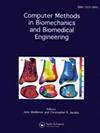Validation of patient-specific flatfoot models on finite element analysis.
IF 1.7
4区 医学
Q3 COMPUTER SCIENCE, INTERDISCIPLINARY APPLICATIONS
Computer Methods in Biomechanics and Biomedical Engineering
Pub Date : 2024-10-17
DOI:10.1080/10255842.2024.2417228
引用次数: 0
Abstract
Adult-acquired flatfoot causes various deformities. If a patient-specific foot model can be created using the finite element method, it can be used to study the appropriate surgical technique for each patient. Nine patient-specific flatfoot models were created, and loading simulations were performed. To validate the models, the patients' weight-bearing radiographs were compared with the parameters of the models. The CCC values ranged from 0.917 to 0.993 , all exceeding the moderate threshold according to the McBride criteria. Our model reproduces the biomechanics of a patient's foot under loading conditions, which may be useful for investigating patient-specific surgical procedures.
通过有限元分析验证患者专用扁平足模型。
成人获得性扁平足会导致各种畸形。如果能使用有限元方法创建患者专用的足部模型,就能用于研究适合每位患者的手术技术。我们创建了九个患者专用的扁平足模型,并进行了加载模拟。为了验证模型,将患者的负重X光片与模型参数进行了比较。CCC值从0.917到0.993不等,均超过了麦克布莱德标准规定的中度临界值。我们的模型再现了患者足部在加载条件下的生物力学,这可能有助于研究特定患者的手术过程。
本文章由计算机程序翻译,如有差异,请以英文原文为准。
求助全文
约1分钟内获得全文
求助全文
来源期刊
CiteScore
4.10
自引率
6.20%
发文量
179
审稿时长
4-8 weeks
期刊介绍:
The primary aims of Computer Methods in Biomechanics and Biomedical Engineering are to provide a means of communicating the advances being made in the areas of biomechanics and biomedical engineering and to stimulate interest in the continually emerging computer based technologies which are being applied in these multidisciplinary subjects. Computer Methods in Biomechanics and Biomedical Engineering will also provide a focus for the importance of integrating the disciplines of engineering with medical technology and clinical expertise. Such integration will have a major impact on health care in the future.

 求助内容:
求助内容: 应助结果提醒方式:
应助结果提醒方式:


